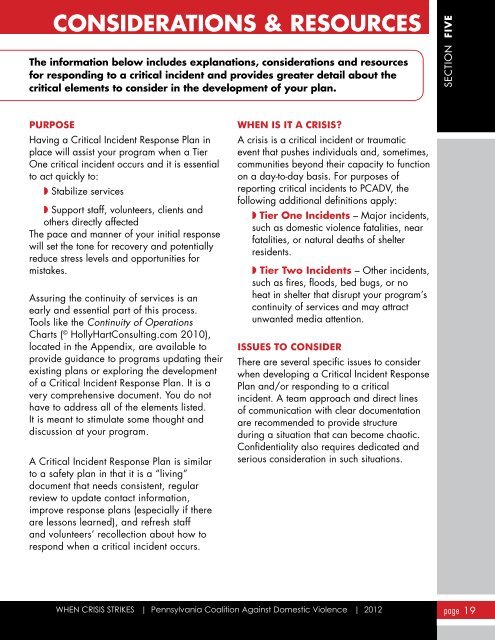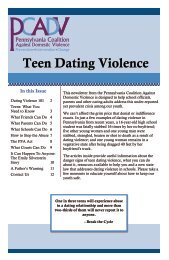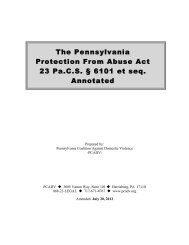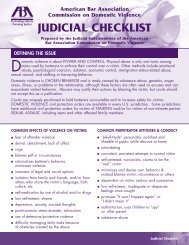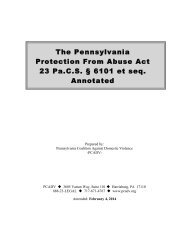Toolkit with Report Form - Pennsylvania Coalition Against Domestic ...
Toolkit with Report Form - Pennsylvania Coalition Against Domestic ...
Toolkit with Report Form - Pennsylvania Coalition Against Domestic ...
Create successful ePaper yourself
Turn your PDF publications into a flip-book with our unique Google optimized e-Paper software.
Considerations & resources<br />
The information below includes explanations, considerations and resources<br />
for responding to a critical incident and provides greater detail about the<br />
critical elements to consider in the development of your plan.<br />
Section five<br />
Purpose<br />
Having a Critical Incident Response Plan in<br />
place will assist your program when a Tier<br />
One critical incident occurs and it is essential<br />
to act quickly to:<br />
◗ Stabilize services<br />
◗ Support staff, volunteers, clients and<br />
others directly affected<br />
The pace and manner of your initial response<br />
will set the tone for recovery and potentially<br />
reduce stress levels and opportunities for<br />
mistakes.<br />
Assuring the continuity of services is an<br />
early and essential part of this process.<br />
Tools like the Continuity of Operations<br />
Charts ( © HollyHartConsulting.com 2010),<br />
located in the Appendix, are available to<br />
provide guidance to programs updating their<br />
existing plans or exploring the development<br />
of a Critical Incident Response Plan. It is a<br />
very comprehensive document. You do not<br />
have to address all of the elements listed.<br />
It is meant to stimulate some thought and<br />
discussion at your program.<br />
A Critical Incident Response Plan is similar<br />
to a safety plan in that it is a “living”<br />
document that needs consistent, regular<br />
review to update contact information,<br />
improve response plans (especially if there<br />
are lessons learned), and refresh staff<br />
and volunteers’ recollection about how to<br />
respond when a critical incident occurs.<br />
When is it a crisis?<br />
A crisis is a critical incident or traumatic<br />
event that pushes individuals and, sometimes,<br />
communities beyond their capacity to function<br />
on a day-to-day basis. For purposes of<br />
reporting critical incidents to PCADV, the<br />
following additional definitions apply:<br />
◗ Tier One Incidents – Major incidents,<br />
such as domestic violence fatalities, near<br />
fatalities, or natural deaths of shelter<br />
residents.<br />
◗ Tier Two Incidents – Other incidents,<br />
such as fires, floods, bed bugs, or no<br />
heat in shelter that disrupt your program’s<br />
continuity of services and may attract<br />
unwanted media attention.<br />
issues to consider<br />
There are several specific issues to consider<br />
when developing a Critical Incident Response<br />
Plan and/or responding to a critical<br />
incident. A team approach and direct lines<br />
of communication <strong>with</strong> clear documentation<br />
are recommended to provide structure<br />
during a situation that can become chaotic.<br />
Confidentiality also requires dedicated and<br />
serious consideration in such situations.<br />
When Crisis Strikes | <strong>Pennsylvania</strong> <strong>Coalition</strong> <strong>Against</strong> <strong>Domestic</strong> Violence | 2012 page 19


